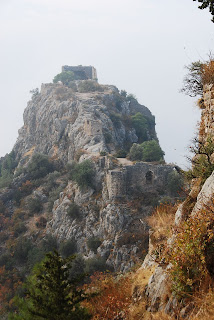For those of you who have actual poetic talent, İ apologize. For the rest of you, İ hope you enjoy this poetic overview of this bicycle journey expressed in the form of a series of haiku.
Matsuo Basho is doubtless turning over in his grave.
2002
China
Buying ink brushes
Paying respects to Xuan Zang
Leaving from Xian
Chinese emperors
Lie in vast mausolea
Dead and forgotten
Buddhist cave temples
Honeycomb arid hillsides
Silk Road's eastern end
Cycling through cold mist
Tracing Gansu Corridor
Camped beside Great Wall
Homicidal bees
Pursue me across desert
Anxi oasis
Hot dry hurricanes
Dessicate a roadside corpse
Crossing the Gobi
Travel companions
Across the Taklamakan
Swift-riding Uighurs
Beziklik, Dunhuang
Frescoes adorn rock-hewn caves
Trail of spreading faith
Blazing heat hammers
Tourists in Gaochang, Turfan
Beer under grape vines
Pain spreads slowly through
Swelling joints in Urumqi
Journey suspended
2004
China
Return to deathbed
In rain-lashed grey Urumqi
Two long years later
Otherworldly blue
Propelled by gale-force tailwinds
Leaving Sayram Lake
Kazakhstan
Welcoming shepherds
As I ride across bleak steppe
Cold early springtime
Kyrgyzstan
Farcical frontier
Drawn across boggy valley
Of Scythian tombs
Warm sunshine lights up
Ancient rock-carved hunting scenes
Of Lake Issyk Kol
Mountain passes loom
Aching muscles climb all day
Cycling with Pushkin
Kebabs, beer, bread, borshcht
Filling my empty stomach
Chaikhana in Osh
Fast-moving blizzard
Freezes us on mountainside
Revived in warm yurt
Under Pamir peaks
Detained by bribe-seeking guards
Saved by football match
Tajikistan
Dead yaks mark border
High desert home to slaughtered
Marco Polo sheep
Lenin's statue stands
Above power-line fores
Rain-drenched Murghab town
Source of the Oxus
Defended by flood ramparts
We retreat, muddy
Cold rainy grasslands
Kyrgyz herders shelter us
Crossing the Pamirs
Along Afghan frontier
Hindu Kush towers above
We pedal hungry
Guest of expats
I eat, rest, eat, rest and eat
Break in Dushanbe
Alpine scenery
Crossing the Fan Mountains
Farewell dear Tajiks
Uzbekistan
Stung at border
Cheated times uncountable
Uzbeks rip me off
Floating dream-like blue
Above ancient mud brick domes
Samarkand awes me
Antique minaret
Glowers over timeless town
Gorgeous Bukhara
Ghostly empty streets
Open air museum town
Deserted Khiva
Turkmenistan
Golden statues stand
In soulless dusty towns
Damn Turkmenbashi
Heat like sledge hammers
Mongol-ruined cityscape
Camping inside Merv
Iran
Vodka and cherry
Homemade wine, date palm liqueur
Life in dry Iran
Carpets and pilgrims
Line streets beneath golden dome
Two days in Meshhad
Caravansarai
That once housed Marco Polo
My nighttime shelter
Flawless lines rise up
To a rocket-like apex
Gonbad e Kavus
Two day summit dash
Scotch on peak, hot springs after
Climbing Damavand
Endless traffic jam
Leads into smog-choked Tehran
My time has run out
2009
Iran
Smiles of real welcome
Curious conversations
Welcome to Iran
Sweating through dust haze
Battling traffic lunacy
I dream of water
Cold drinks on roadside
Picnics, dinners, veggies, fruit
Hospitality
Heineken and Scotch
Saadi's graveside poetry
Shiraz in summer
Persian capital
Tombs of long-dead emperors
Persepolis pomp
Tiles shimmer in sun
Mud brick towers, minarets
Esfahan wonder
Assassin castles
Lakeside picnics and swimming
Cycling the Elborz
Dashing cross the steppe
I spot a huge manmade shape
Soltaniyeh's dome
Torrential rainstorms
Kneedeep litter beside road
Caspian seashore
Azerbaijan
Water fountain burns
Gazelles frolic, headwinds howl
Riding to Baku
Oasis of ease
In Art Deco cityscape:
Hostess Natalya
Waves of green hills rise
Higher than the eye can see
Rainy Xinaliq
Returning from the hills
Slope and wind co-operate
Flying Baku-wards
Seki exudes charm
Kish village breathes history
Pedal self-destructs
Like a bad conscience
Huge faces loom by roadside
Cult of Iliev
Georgia
Rolling through vineyards
Past fortresses and castles
Kakheti charms me
Climbing to the sky
A sweat-soaked muddy goat track
The Abano Pass
Wine, khinkali, song
Horse-riding, mountain biking
Tusheti idyll
Good-humoured people
In historic countryside
Georgia's on my mind
Rushing stream waters
Orchards, meadows, village greens
Khevsureti jaunt
Towering ice peak
Backdrop for mountain freedom
Kazbegi sidetrip
Forty-first birthday
In Tbilisi old town
Cyclists' rendezvous
Armenia and Nagorno-Karabakh
Deserted churches
Sport intricate stone carving
Armenian soul
Soviet greyness
Blights church-studded valleyscape
Debed Canyon ride
Like desert roses
Beautiful women light up
Ugly Yerevan
Dancing teenagers
Greek temple adorns bleak slopes
Geghard and Garni
Fruit and veg harvest
Ararat looms in background
Fleeing Yerevan
Roller coaster ride
Karahundj stones salute sky
Cycling through cold rain
Forested mountains
Soaked in blood of civil war
Remote Karabakh
Snow line creeps downhill
Industrial wastelands pass
Farewell Hayastan
Georgia (reprise)
Mud road to nowhere
Frozen forgotten highlands
Vardzia appears
Turkey
Fall colours glowing
Highlight volcanic landscape
On the road to Kars
Earthquake-shattered scene
Half-standing churches teeter
By Ani's chasm
Sneering begging brats
Hurl stones and bid dogs attack
True Kurdish welcome
Urartu fortress
Ancient temple hieroglyphs
Dust of history
Magic citadel
Old bridge, graceful minaret
Poor doomed Hasankeyf
Byzantine steeples
Where now few Christians live
Scenic Tur Abdin
Iraq
Comfortingly dull
Smiles of genuine welcome
Iraqi detour
Turkey (reprise)
Desert blooms cotton
Trucks thunder across lowlands
I near journey's end
Temples of the moon
Harran's eternal story
Lost limestone hamlets
Modern city growls
Around baklava cafes
Antep's mosaics
Ancient Antioch
Leaves little to be seen now
But Roman tilework
Armenian ruins
Hgih-perching castles look down
Cilician plain
Lightning and hailstorm
Herald my victory lap
Venetian Ayas
Watching rain pour down
Remembering journey highlights
Melancholic joy











